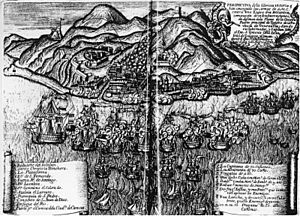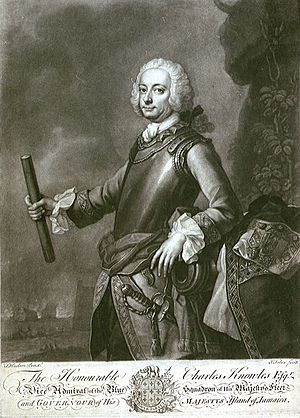Battle of La Guaira facts for kids
Quick facts for kids Battle of La Guaira |
|||||||
|---|---|---|---|---|---|---|---|
| Part of the War of Jenkins' Ear | |||||||
 Engraving of the attack by the British fleet on La Guayra (1743) |
|||||||
|
|||||||
| Belligerents | |||||||
| Commanders and leaders | |||||||
| Charles Knowles Chaloner Ogle |
Gabriel de Zuloaga Mateo Gual José de Iturriaga |
||||||
| Strength | |||||||
| Land: 2,400 Sea: 8 ships of line 9 frigates, bomb vessels and fireships, 2 transports |
1,000 | ||||||
| Casualties and losses | |||||||
| ~600 killed ~1,300 total |
300 killed or wounded | ||||||
The Battle of La Guaira was an important naval battle that happened on March 2, 1743. It took place in the Caribbean Sea, right off the coast of La Guaira, which is now part of Venezuela. This battle was part of a bigger conflict called the War of Jenkins' Ear. La Guaira was a key port for the Spanish, helping them move troops and supplies.
A British fleet, led by Sir Charles Knowles, tried to capture the port. However, the Spanish defenders successfully fought them off. The British forces suffered heavy losses, with about 600 men killed. Many of their ships were also badly damaged. This defeat meant the British expedition failed.
Contents
Why the Battle Happened
The War of Jenkins' Ear
The Battle of La Guaira was part of the War of Jenkins' Ear. This war was fought between Great Britain and Spain. It started because of trade disputes and a story about a British captain's ear being cut off by the Spanish. The British wanted to weaken Spain's power in the Americas.
British Plans to Attack Spanish Ports
After some earlier defeats, the British navy decided to attack other important Spanish ports. Chaloner Ogle, a British admiral, thought La Guaira would be an easy target. He believed it was not as well-defended as other Spanish cities.
On February 22, 1743, Sir Charles Knowles sailed from the island of Antigua. He had a fleet of 19 ships. Knowles thought La Guaira would be easy to capture.
Spanish Preparations for Defense
However, the Spanish had been warned about the attack. They had two months to get ready. They brought in more soldiers and got extra gunpowder from the Dutch. This meant La Guaira was much stronger than the British expected.
The Battle Unfolds
British Fleet Arrives
On the morning of the battle, Knowles's ships were about 15 miles (24 km) east of La Guaira. Spanish lookouts quickly spotted them and lit signal fires. These fires warned everyone in La Guaira and nearby Caracas.
Governor Gabriel de Zuloaga rushed to the coast. He brought many militia soldiers with him. The Spanish garrison commander, Mateo Gual, and Captain José Iturriaga prepared their defenses. They had plenty of gunpowder.
Fierce Fighting Begins
Around midday, the British ships, including HMS Burford, Eltham, and Norwich, moved into position. They anchored in a double line and began firing at the port. The Spanish fired back with great accuracy from their six batteries.
The Spanish defense was much stronger than the British had expected. Also, a heavy ocean swell made it hard for the British to land any troops. This prevented them from attacking by land.
British Ships Retreat
After about three and a half hours, HMS Burford was badly damaged. It had to cut its anchor cable and move away from the fighting. The frigate Eltham was also damaged. These ships accidentally crashed into HMS Norwich. All three ships had to leave the battle. This weakened the British attack.
The shooting stopped around 8:00 P.M. The damaged HMS Burford and other ships had to find shelter. The British tried to continue the attack the next morning with a bomb vessel, but it was not very effective.
On March 5, Knowles sent small boat parties to try and board a French merchant ship in the harbor. However, they were discovered and driven off by the Spanish.
After the Battle
British Retreat and Losses
After three days of fighting, the British had suffered heavy losses. They had 97 men killed and 308 wounded. Sir Charles Knowles decided to give up on La Guaira. He planned to attack another port called Puerto Cabello instead.
However, some of his damaged ships went to Curaçao for repairs instead of meeting him. Knowles had to follow them. He tried to attack Puerto Cabello later, but strong winds and currents made it impossible. The British expedition ended in failure.
See also
 In Spanish: Batalla de La Guaira para niños
In Spanish: Batalla de La Guaira para niños


